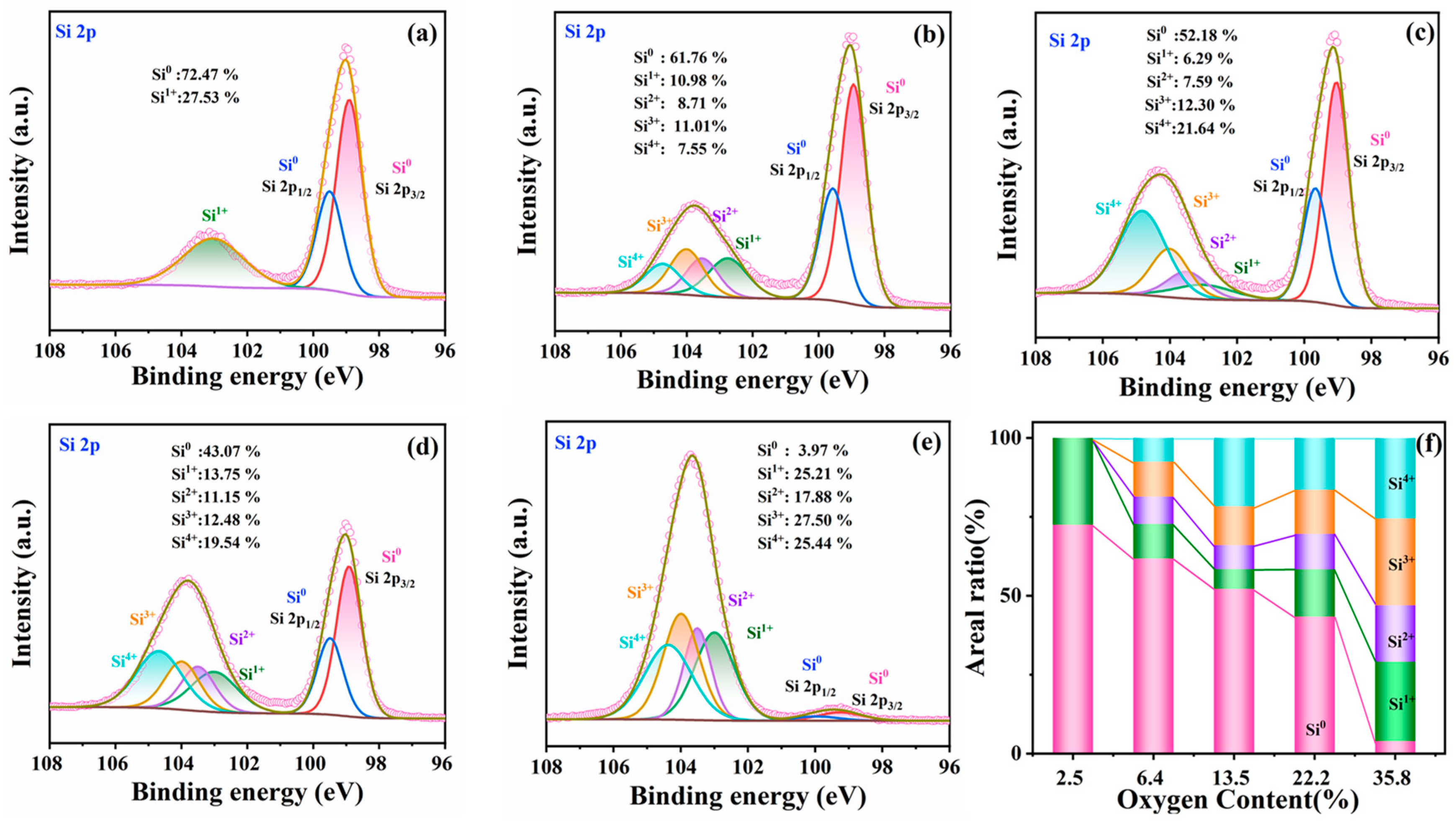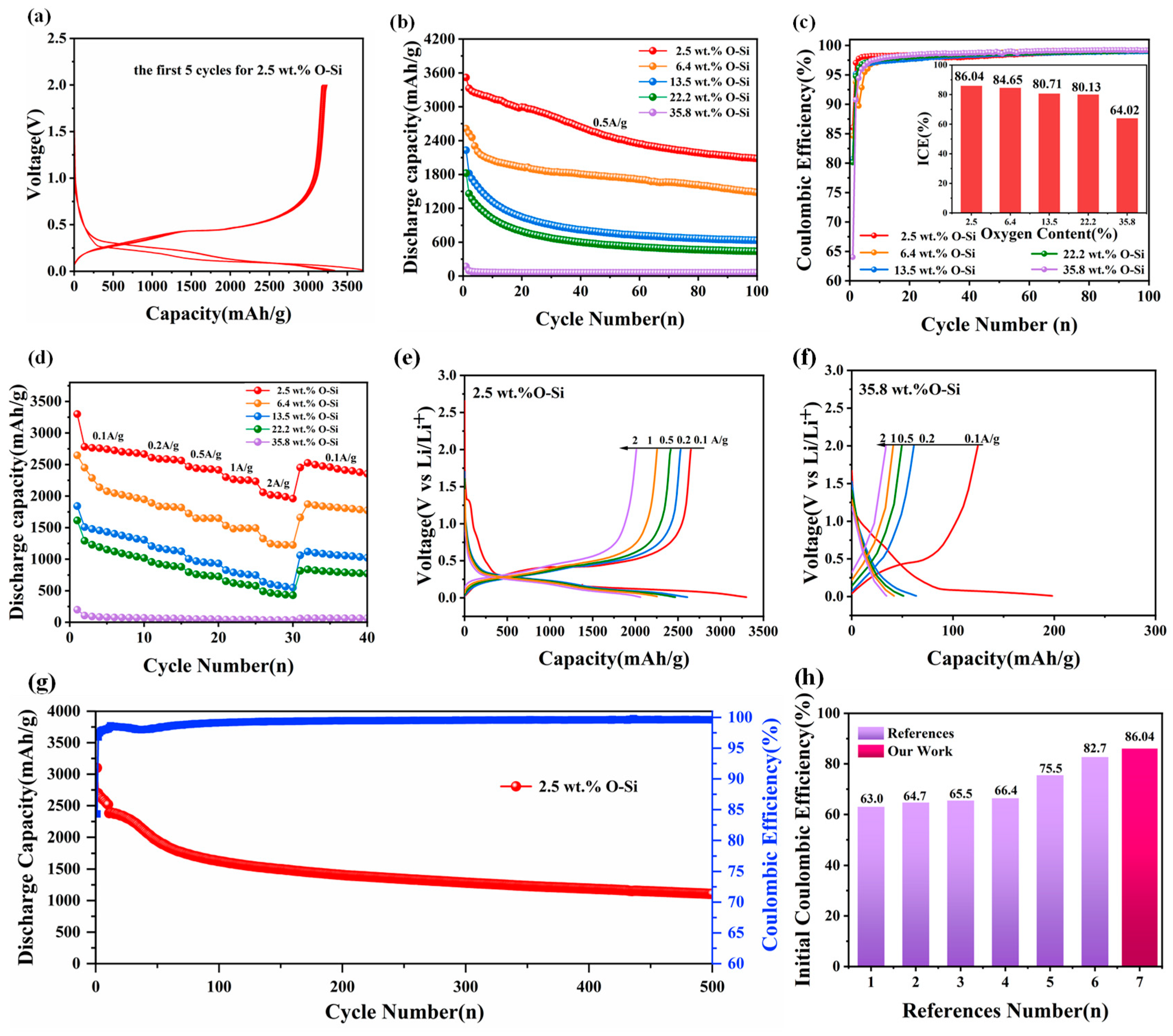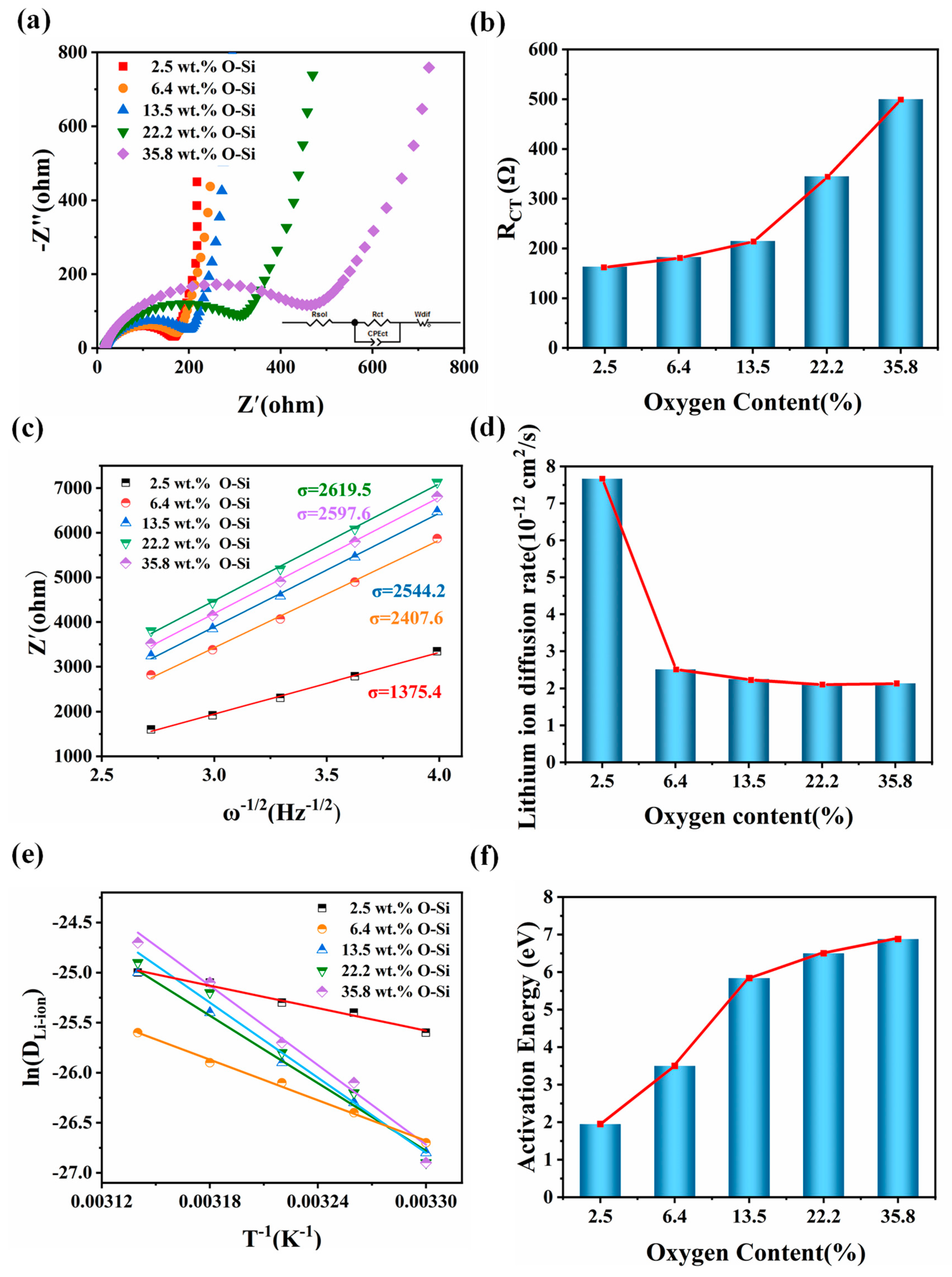Controlling Oxidation of Kerf Loss Silicon Waste Enabling Stable Battery Anode
Abstract
:1. Introduction
2. Experimental
2.1. Material Preparation
2.2. Material Characterization
2.3. Electrochemical Measurement
3. Results and Discussion
4. Conclusions
Supplementary Materials
Author Contributions
Funding
Data Availability Statement
Conflicts of Interest
References
- Shi, J.; Sheng, L.; Li, J.; Liu, G. Green Synthesis of High-Performance Porous Carbon Coated Silicon Composite Anode for Lithium Storage Based on Recycled Silicon Kerf Waste. J. Alloys Compd. 2022, 919, 165854. [Google Scholar] [CrossRef]
- Wei, D.; Kong, J.; Zhang, Z.; Xing, P.; Zhuang, Y. Study on recycling Si from silicon diamond-wire saw cutting waste by a slag refining process in industrial scale. J. Clean. Prod. 2023, 398, 136557. [Google Scholar] [CrossRef]
- Thomassen, G.; Dewulf, J.; Passel, S.V. Prospective material and substance flow analysis of the end-of-life phase of crystalline silicon-based PV modules. Resour. Conserv. Recycl. 2022, 176, 105917. [Google Scholar] [CrossRef]
- Yu, Y.L.; Bai, X.; Li, S.Y.; Shi, J.H.; Wang, L.; Xi, F.S.; Ma, W.H.; Deng, R. Review of Silicon Recovery in the Photovoltaic Industry. Curr. Opin. Green Sustain. Chem. 2023, 44, 100870. [Google Scholar] [CrossRef]
- Wang, L.; Jiang, Y.; Li, S.Y.; Chen, X.H.; Xi, F.S.; Wan, X.H.; Ma, W.H.; Deng, R. Scalable synthesis of N-doped Si/G@voids@C with porous structures for high-performance anode of lithium-ion batteries. Rare Met. 2023, 42, 4094102. [Google Scholar] [CrossRef]
- Cao, L.; Xiao, R.S.; Wang, J.B.; Li, S.Y.; Xu, J.J.; Huang, T. Recycling Waste Al–Si Alloy for Micrometer-Sized Spongy Si with High Areal/Volumetric Capacity and Stability in Lithium-Ion Batteries. ACS Sustain. Chem. Eng. 2022, 10, 8143–8150. [Google Scholar] [CrossRef]
- Ma, Y.C.; Huang, A.M.; Li, Y.; Jiang, H.C.; Zhang, W.; Zhang, L.; Li, L.L.; Peng, S.J. Simple preparation of Si/N-doped carbon anodes from photovoltaic industry waste for lithium-ion batteries. J. Alloys Compd. 2024, 890, 161792. [Google Scholar] [CrossRef]
- Xi, F.S.; Zhang, Z.; Hu, Y.; Li, S.Y.; Ma, W.H.; Chen, X.H.; Wan, X.H.; Chong, C.M.; Luo, B.; Wang, L. PSi@SiOx/Nano-Ag composite derived from silicon cutting waste as high-performance anode material for Li-ion batteries. J. Hazard. Mater. 2021, 414, 125480. [Google Scholar] [CrossRef] [PubMed]
- Liu, W.W.; Liu, J.; Zhu, M.H.; Wang, W.Y.; Wang, L.; Xie, S.X.; Wang, L.; Yang, X.L.; He, X.M.; Sun, Y.M. Recycling of Lignin and Si Waste for Advanced Si/C Battery Anodes. ACS Appl. Mater. Interfaces 2020, 12, 57055–57063. [Google Scholar] [CrossRef]
- Wang, K.; Tan, Y.; Li, P.; Wang, Y.P. Recycling Si waste cut from diamond wire into high performance porous Si@SiO2@C anodes for Li-ion battery. J. Hazard. Mater. 2020, 407, 124778. [Google Scholar] [CrossRef]
- Liao, Q.J.; Li, S.Y.; Xi, F.S.; Tong, Z.Q.; Chen, X.H.; Wan, X.H.; Ma, W.H.; Deng, R. High-performance silicon carbon anodes based on value-added recycling strategy of end-of-life photovoltaic modules. Energy 2023, 281, 128345. [Google Scholar] [CrossRef]
- Zhang, J.K.; Li, S.Y.; Xi, F.S.; Wan, X.H.; Ding, Z.; Chen, Z.J.; Ma, W.H.; Deng, R. Si@SiOx/Ag composite anodes with high initial coulombic efficiency derive from recyclable silicon cutting waste. Chem. Eng. J. 2022, 447, 137563. [Google Scholar] [CrossRef]
- Lu, J.J.; Liu, S.L.; Liu, J.H.; Qian, G.Y.; Wang, D.; Gong, X.Z.; Deng, Y.D.; Chen, Y.N.; Wang, Z. Millisecond Conversion of Photovoltaic Silicon Waste to Binder-Free High Silicon Content Nanowires Electrodes. Adv. Energy Mater. 2021, 11, 2102103. [Google Scholar] [CrossRef]
- Guo, J.G.; Zhai, W.; Sun, Q.; Ai, Q.; Li, J.; Cheng, J.; Dai, L.N.; Ci, L.J. Facilely tunable core-shell Si@SiOx nanostructures prepared in aqueous solution for lithium ion battery anode. Electrochim. Acta 2020, 342, 136068. [Google Scholar] [CrossRef]
- Abel, P.R.; Lin, Y.; Celio, H.; Heller, A.; Mullins, C.B. Improving the stability of nanostructured silicon thin film lithium-ion battery anodes through their controlled oxidation. ACS Nano 2012, 63, 2506–2516. [Google Scholar] [CrossRef] [PubMed]
- Kim, K.; Park, J.H.; Doo, S.G.; Kim, T. Effect of oxidation on Li-ion secondary battery with non-stoichiometric silicon oxide (SiOx) nanoparticles generated in cold plasma. Thin Solid Film. 2010, 518, 6547–6549. [Google Scholar] [CrossRef]
- Kalidas, N.; Shen, X.; Yuan, M.; Zhao, X.; Lehto, V.P. Controlled surface oxidation of mesoporous silicon microparticles to achieve a stable Si/SiOx anode for lithium-ion batteries. Microporous Mesoporous Mater. 2022, 344, 112243. [Google Scholar] [CrossRef]
- Cho, J.H.; Xiao, X.; Verbrugge, M.W.; Sheldon, B.W. Influence of Oxygen Content on the Structural Evolution of SiOx Thin-Film Electrodes with Subsequent Lithiation/Delithiation Cycles. ACS Appl. Energy Mater. 2022, 5, 13293–13306. [Google Scholar] [CrossRef]
- Lee, J.; Han, S.A.; Lee, S.M.; Park, M.S.; Kim, J.H. Electrochemical properties of nonstoichiometric silicon suboxide anode materials with controlled oxygen concentration. Compos. Part B 2019, 174, 107024. [Google Scholar] [CrossRef]
- Curtis, A.; Küppers, B.; Möllnitz, S.; Khodier, K.; Sarc, R. Real time material flow monitoring in mechanical waste processing and the relevance of fluctuations. Waste Manag. 2020, 120, 687–697. [Google Scholar] [CrossRef]
- Wang, L.; Xi, F.S.; Zhang, Z.; Li, S.Y.; Chen, X.H.; Wan, X.J.; Ma, W.H.; Deng, R.; Chong, C.M. Recycling of photovoltaic silicon waste for high-performance porous silicon/silver/carbon/graphite anode. Waste Manag. 2021, 132, 56–63. [Google Scholar] [CrossRef] [PubMed]
- Wang, M.Y.; Xi, F.S.; Li, S.Y.; Ma, W.H.; Wan, X.H.; Tong, Z.Q.; Luo, B. ZIF-67-derived porous nitrogen-doped carbon shell encapsulates photovoltaic silicon cutting waste as anode in high-performance lithium-ion batteries. J. Electroanal. Chem. 2023, 931, 117210. [Google Scholar] [CrossRef]
- Zhou, H.; Liu, J.Z.; Guo, L.S.; Zhang, J.Y.; Feng, S.; Zhang, X.M. Disproportionated SiOx/C composite anode materials for lithium-ion batteries. Colloids Surf. 2022, 648, 129386. [Google Scholar] [CrossRef]
- Zheng, G.R.; Xiang, Y.X.; Xu, L.F.; Luo, H.; Wang, B.L.; Liu, Y.; Han, X.; Zhao, W.M.; Chen, S.J.; Chen, H.L.; et al. Controlling Surface Oxides in Si/C Nanocomposite Anodes for High-Performance Li-Ion Batteries. Adv. Energy Mater. 2018, 8, 1801718. [Google Scholar] [CrossRef]
- Ge, G.F.; Li, G.C.; Wang, X.C.; Chen, X.X.; Fu, L.; Liu, X.X.; Mao, E.Y.; Liu, J.; Yang, X.L.; Qian, C.X.; et al. Manipulating oxidation of silicon with fresh surface enabling stable battery anode. Nano Lett. 2021, 21, 3127–3133. [Google Scholar] [CrossRef] [PubMed]
- Xun, S.; Song, X.; Wang, L.; Grass, M.E.; Liu, Z.; Battaglia, V.S.; Liu, G. The Effects of Native Oxide Surface Layer on the Electrochemical Performance of Si Nanoparticle-Based Electrodes. J. Electrochem. Soc. 2011, 158, A1260. [Google Scholar] [CrossRef]
- Zhou, W.; Upreti, S.; Whittingham, M.S. Electrochemical performance of Al–Si–graphite composite as anode for lithium–ion batteries. Electrochem. Commun. 2011, 13, 58–161. [Google Scholar] [CrossRef]
- Shen, L.; Xu, C.J.; Gao, J.G.; Tao, J.M.; Zhang, Q.B.; Chen, Y.; Lin, Y.B.; Huang, Z.G.; Li, J.X. Scalable synthesized high-performance TiO2-Si-C hybrid anode for lithium batteries. J. Energy Chem. 2022, 77, 348–358. [Google Scholar] [CrossRef]
- Niu, J.; Zhang, S.; Niu, Y.; Song, H.H.; Chen, X.H.; Zhou, J.S.; Cao, B. Direct amination of Si nanoparticles for the preparation of Si@ultrathin SiOx@graphene nanosheets as high performance lithium-ion battery anodes. J. Mater. Chem. 2015, 3, 19892–19900. [Google Scholar] [CrossRef]
- Bahruji, H.; Bowker, M.; Davies, P.R. Photoactivated reaction of water with silicon nanoparticles. Int. J. Hydrogen Energy 2009, 34, 8504–8510. [Google Scholar] [CrossRef]
- Yogi, P.; Tanwar, M.; Saxena, S.K.; Mishra, S.; Pathak, D.K.; Chaudhary, A.; Sagdeo, P.R.; Kumar, R. Quantifying the Short-Range Order in Amorphous Silicon by Raman Scattering. Anal. Chem. 2018, 9013, 8123–8129. [Google Scholar] [CrossRef] [PubMed]
- Gupta, S.K.; Jha, P.K. Modified phonon confinement model for size dependent Raman shift and linewidth of silicon nanocrystals. Solid State Commun. 2009, 149, 1989–1992. [Google Scholar] [CrossRef]
- Wang, R.; Zhou, G.; Liu, Y.; Pan, S.H.; Zhang, H.; Yu, D.; Zhang, Z. Raman spectral study of silicon nanowires: High-order scattering and phonon confinement effects. Phys. Rev. B 2000, 61, 16827–16832. [Google Scholar] [CrossRef]
- Miller, M.L.; Linton, R.W. X-ray photoelectron spectroscopy of thermally treated silica (SiO2) surfaces. Anal. Chem. 1985, 57, 2314–2319. [Google Scholar] [CrossRef]
- Nguyen, T.P.; Lefrant, S. XPS study of SiO thin films and SiO-metal interfaces. J. Phys. Condens. Matter 1989, 1, 5197–5204. [Google Scholar] [CrossRef]
- Park, B.; Kim, J.; Kang, D.; Jeong, C.; Kim, K.S.; Kim, J.U.; Yoo, P.J.; Kim, T. Dramatically Enhanced Mechanosensitivity and Signal-to-Noise Ratio of Nanoscale Crack-Based Sensors: Effect of Crack Depth. Adv. Mater. 2016, 28, 8130–8137. [Google Scholar] [CrossRef] [PubMed]
- Huang, R.; Fan, X.; Shen, W.; Jing, Z. Carbon-coated silicon nanowire array films for high-performance lithium-ion battery anodes. Appl. Phys. Lett. 2009, 95, 133119. [Google Scholar] [CrossRef]
- Forney, M.; Ganter, M.; Staub, J.; Rdigley, R.; Landi, B. Prelithiation of silicon-carbon nanotube anodes for lithium ion batteries by stabilized lithium metal powder (SLMP). Nano Lett. 2013, 13, 4158. [Google Scholar] [CrossRef] [PubMed]
- Pan, Q.R.; Zuo, P.J.; Mu, T.S.; Du, C.; Cheng, X.Q.; Ma, Y.L.; Gao, Y.Z.; Yin, G.P. Improved electrochemical performance of micro-sized SiO-based composite anode by prelithiation of stabilized lithium metal powder. J. Power Sources 2017, 347, 170. [Google Scholar] [CrossRef]
- Lv, P.P.; Zhao, H.L.; Gao, C.H.; Zhang, T.H.; Liu, X. Highly efficient and scalable synthesis of SiOx/C composite with core-shell nanostructure as high-performance anode material for lithium ion batteries. Electrochim. Acta 2015, 152, 345–351. [Google Scholar] [CrossRef]
- An, W.L.; Gao, B.; Mei, S.; Xiang, B.; Fu, J.; Wang, L.; Zhang, Q.; Chu, P.K.; Huo, K. Scalable synthesis of ant-nest-like bulk porous silicon for high-performance lithium-ion battery anodes. Nat. Commun. 2019, 10, 1447. [Google Scholar] [CrossRef] [PubMed]
- Sun, J.; Shi, J.; Ban, B.; Li, J.; Wei, M.; Wang, Q.; Chen, J. Porous Si/C anode materials by Al-Si dealloying method with PEA surfactant assisted cross-linked carbon coating for lithium-ion battery applications. Electrochim. Acta 2019, 327, 134995. [Google Scholar] [CrossRef]
- Zhang, J.Y.; Zhang, C.Q.; Liu, Z.; Zheng, J.; Zuo, Y.H.; Xue, C.L.; Li, C.B.; Cheng, B.W. High-performance ball-milled SiOx anodes for lithium ion batteries. J. Power Sources 2017, 339, 86–92. [Google Scholar] [CrossRef]
- Li, H.F.; Liu, D.; Zhang, L.; Qian, K.; Shi, R.; Kang, F.; Li, B. Combination Effect of Bulk Structure Change and Surface Rearrangement on the Electrochemical Kinetics of LiNi0.80Co0.15Al0.05O2 During Initial Charging Processes. ACS Appl. Mater. Interfaces 2018, 1048, 41370–41379. [Google Scholar] [CrossRef] [PubMed]
- Wang, X.; Hao, H.S.; Liu, J.; Huang, T.; Yu, A. A novel method for preparation of macroposous lithium nickel manganese oxygen as cathode material for lithium ion batteries. Electrochim. Acta 2011, 56, 4065–4069. [Google Scholar] [CrossRef]
- Wang, C.; Yang, Y.H.; Lu, D.J.; Guan, R.Z.; Wang, J.Z.; Bian, X.F. Si-based composite deriving from wok ash waste as high-performance anode for Li-ion battery. J. Alloys Compd. 2020, 858, 157680. [Google Scholar] [CrossRef]
- Chan, Y.H.; Wu, M. Electrochemically embedded nickel oxide in a highly porous manganese oxide film with enhanced catalytic kinetics of the urea oxidation reaction. J. Alloys Compd. 2022, 930, 167391. [Google Scholar] [CrossRef]
- Yang, X.Q.; Huang, H.; Li, Z.J.; Zhong, M.L.; Zhang, G.Q.; Wu, D.C. Preparation and lithium-storage performance of carbon/silica composite with a unique porous bicontinuous nanostructure. Carbon 2014, 77, 275–280. [Google Scholar] [CrossRef]
- Xu, L.; He, Y.B.; Miao, C.; Qin, X.; Lv, W.; Du, H.; Li, B.; Yang, Q.; Kang, F. Carbon coated porous tin peroxide/carbon composite electrode for lithium-ion batteries with excellent electrochemical properties. Carbon 2015, 81, 739–747. [Google Scholar]
- Paloukis, F.; Elmasides, C.; Farmakis, F.; Selinis, P.; Neophytides, S.G.; Georgoulas, N. Electrochemical Impedance Spectroscopy study in micro-grain structured amorphous silicon anodes for lithium-ion batteries. J. Power Sources 2016, 331, 285–292. [Google Scholar] [CrossRef]
- Wang, Y.; Wu, H.B.; Huang, L.; Zhao, H.; Liu, Z.; Chen, X.; Liu, H.; Zhang, Y. Hierarchically Porous N,S-Codoped Carbon-Embedded Dual Phase MnO/MnS Nanoparticles for Efficient Lithium Ion Storage. Inorg. Chem. 2018, 5713, 7993–8001. [Google Scholar] [CrossRef] [PubMed]
- Malik, R.; Loveridge, M.J.; Williams, L.J.; Huang, Q.; West, G.; Bhagat, R.; Walton, R.I. Porous Metal-Organic Frameworks for Enhanced Performance Silicon Anodes in Lithium-Ion Batteries. Chem. Mater. 2019, 31, 4156–4165. [Google Scholar] [CrossRef]
- Liu, J.F.; Qi, Y.F.; Fu, B.; Dai, J.F.; Wang, Q.; Zhu, X.J.; Shi, X.Y. Li+ diffusion kinetics of SnS2 nanoflowers enhanced by reduced graphene oxides with excellent electrochemical performance as anode material for lithium-ion batteries. J. Alloys Compd. 2019, 794, 285–293. [Google Scholar] [CrossRef]
- Lindström, H.; Södergren, S.; Solbrand, A.; Rensmo, H.; Hjelm, J.; Hagfeldt, A.; Lindquist, S.E. Li+ Ion Insertion in TiO2 (Anatase). 1. Chronoamperometry on CVD Films and Nanoporous Films. J. Phys. Chem. B 1997, 101, 7710–7716. [Google Scholar] [CrossRef]
- Thanikaikarasan, S. Role of electrolyte concentration on growth kinetics, film thickness, structural, compositional and optical properties of cadmoselite thin films through electrochemical route. J. Alloys Compd. 2021, 885, 160963. [Google Scholar] [CrossRef]
- Long, Z.X.; Fu, R.S.; Ji, J.J.; Feng, Z.Y.; Liu, Z.P. Unveiling the Effect of Surface and Bulk Structure on Electrochemical Properties of Disproportionated SiOx Anodes. ChemNanoMat 2020, 5, 150. [Google Scholar] [CrossRef]
- Zhou, X.Z.; Qi, Z.Y.; Jiang, Y.Y.; Yan, P.F.; Ding, J.X.; Wang, H.Y.; Lei, Z.Q. A facile and scalable Fe-Cr decorating strategy to boost the lithium storage of SiOx anode. Electrochim. Acta 2022, 406, 139805. [Google Scholar] [CrossRef]
- Zhang, J.Y.; Ma, P.P.; Zhang, X.M.; Liu, Z.; Zheng, J.; Zuo, Y.H.; Xue, C.L.; Li, C.B. Core-Shell-Structured SiOx-C Composite for Lithium-Ion Battery Anodes. Energy Technol. 2018, 307, 110480. [Google Scholar] [CrossRef]
- Fu, R.S.; Li, Y.S.; Wu, Y.K.; Shen, C.X.; Fan, C.Z.; Liu, Z.P. Controlling siloxene oxidization to tailor SiOx anodes for high performance lithium ion batteries. J. Power Sources 2019, 432, 65–72. [Google Scholar] [CrossRef]







Disclaimer/Publisher’s Note: The statements, opinions and data contained in all publications are solely those of the individual author(s) and contributor(s) and not of MDPI and/or the editor(s). MDPI and/or the editor(s) disclaim responsibility for any injury to people or property resulting from any ideas, methods, instructions or products referred to in the content. |
© 2024 by the authors. Licensee MDPI, Basel, Switzerland. This article is an open access article distributed under the terms and conditions of the Creative Commons Attribution (CC BY) license (https://creativecommons.org/licenses/by/4.0/).
Share and Cite
Jiang, Y.; He, S.; Ma, S.; Xi, F.; Gavrilin, I.M.; Tong, Z.; Lu, J.; Wan, N.; Ma, W.; Zhu, Y.; et al. Controlling Oxidation of Kerf Loss Silicon Waste Enabling Stable Battery Anode. Processes 2024, 12, 1173. https://doi.org/10.3390/pr12061173
Jiang Y, He S, Ma S, Xi F, Gavrilin IM, Tong Z, Lu J, Wan N, Ma W, Zhu Y, et al. Controlling Oxidation of Kerf Loss Silicon Waste Enabling Stable Battery Anode. Processes. 2024; 12(6):1173. https://doi.org/10.3390/pr12061173
Chicago/Turabian StyleJiang, Yan, Sitong He, Siqi Ma, Fengshuo Xi, Ilya M. Gavrilin, Zhongqiu Tong, Jijun Lu, Neng Wan, Wenhui Ma, Yunpeng Zhu, and et al. 2024. "Controlling Oxidation of Kerf Loss Silicon Waste Enabling Stable Battery Anode" Processes 12, no. 6: 1173. https://doi.org/10.3390/pr12061173




